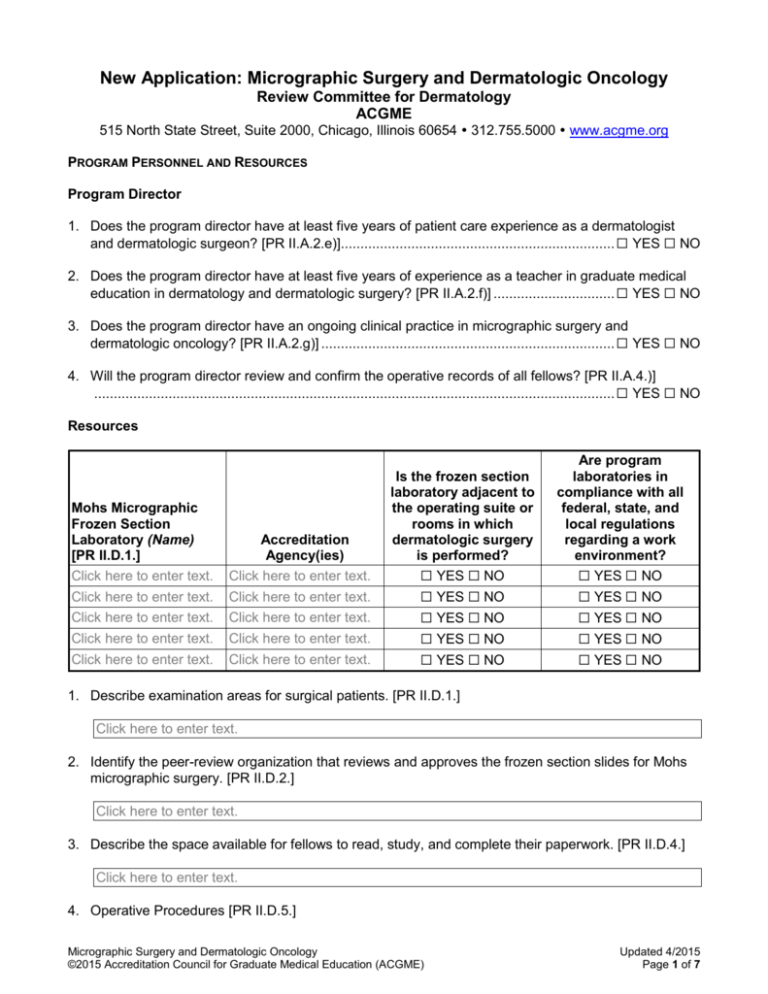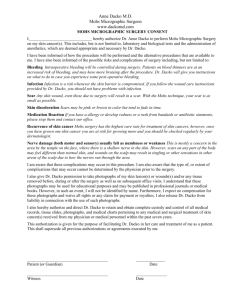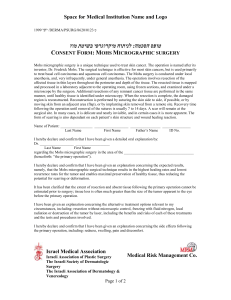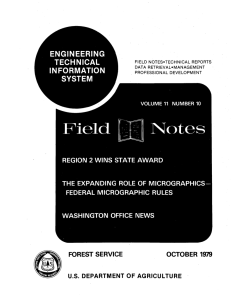Micrographic Surgery and Dermatologic Oncology
advertisement

New Application: Micrographic Surgery and Dermatologic Oncology Review Committee for Dermatology ACGME 515 North State Street, Suite 2000, Chicago, Illinois 60654 312.755.5000 www.acgme.org PROGRAM PERSONNEL AND RESOURCES Program Director 1. Does the program director have at least five years of patient care experience as a dermatologist and dermatologic surgeon? [PR II.A.2.e)]...................................................................... ☐ YES ☐ NO 2. Does the program director have at least five years of experience as a teacher in graduate medical education in dermatology and dermatologic surgery? [PR II.A.2.f)] ............................... ☐ YES ☐ NO 3. Does the program director have an ongoing clinical practice in micrographic surgery and dermatologic oncology? [PR II.A.2.g)] ........................................................................... ☐ YES ☐ NO 4. Will the program director review and confirm the operative records of all fellows? [PR II.A.4.)] ..................................................................................................................................... ☐ YES ☐ NO Resources Are program laboratories in compliance with all federal, state, and local regulations regarding a work environment? ☐ YES ☐ NO Mohs Micrographic Frozen Section Laboratory (Name) [PR II.D.1.] Click here to enter text. Accreditation Agency(ies) Click here to enter text. Is the frozen section laboratory adjacent to the operating suite or rooms in which dermatologic surgery is performed? ☐ YES ☐ NO Click here to enter text. Click here to enter text. ☐ YES ☐ NO ☐ YES ☐ NO Click here to enter text. Click here to enter text. ☐ YES ☐ NO ☐ YES ☐ NO Click here to enter text. Click here to enter text. ☐ YES ☐ NO ☐ YES ☐ NO Click here to enter text. Click here to enter text. ☐ YES ☐ NO ☐ YES ☐ NO 1. Describe examination areas for surgical patients. [PR II.D.1.] Click here to enter text. 2. Identify the peer-review organization that reviews and approves the frozen section slides for Mohs micrographic surgery. [PR II.D.2.] Click here to enter text. 3. Describe the space available for fellows to read, study, and complete their paperwork. [PR II.D.4.] Click here to enter text. 4. Operative Procedures [PR II.D.5.] Micrographic Surgery and Dermatologic Oncology ©2015 Accreditation Council for Graduate Medical Education (ACGME) Updated 4/2015 Page 1 of 7 Provide the number of dermatologic procedures performed in a recent 12-month period at each site identified in ADS. Identify recent 12-month period used: From: Click here to enter a date. To: Click here to enter a date. Ambulatory phlebectomy / vein surgery Botulinum toxin chemodenervation Chemical peel: deep dermal Chemical peel: superficial-epi Dermabrasion Excision - benign lesion Excision - malignant lesion Flaps Grafts (split or full) Hair removal laser Hair transplantation Intense pulsed light Laser (ablation, resurfacing) Lip excision / wedge / vermilionectomy Mohs micrographic surgery Mohs micrographic surgery (complex / large) Nail procedures Repair (closure) simple / intermediate / complex Tumescent liposuction Vascular lesion laser Pigmented lesion laser Non-ablative rejuvenation Rhinophyma correction Scar revision (acne scar or procedure not otherwise listed) Sclerotherapy Soft tissue augmentation / Skin Fillers Other (specify) Other (specify) Site #1 Site #2 Site #3 Site #4 Total # # # # # # # # # # # # # # # # # # # # # # # # # # # # # # # # # # # # # # # # # # # # # # # # # # # # # # # # # # # # # # # # # # # # # # # # # # # # # # # # # # # # # # # # # # # # # # # # # # # # # # # # # # # # # # # # # # # # # # # # # # # # # # # # # # # # # # # # # # # # EDUCATIONAL PROGRAM Patient Care Micrographic Surgery and Dermatologic Oncology ©2015 Accreditation Council for Graduate Medical Education (ACGME) Updated 4/2015 Page 2 of 7 Indicate the settings and activities in which fellows will demonstrate competence in the following areas of patient care. Also indicate the method(s) that will be used to assess competence. Competency Area Making decisions regarding patient treatment, including instances in which the patient prefers to be referred to a different specialty or to a multidisciplinary team [PR IV.A.2.a).(2).(a)] Skin neoplasm destruction techniques, excision, and Mohs micrographic surgery [PR IV.A.2.a).(2).(b).(i)] Cutaneous reconstructive surgery, including random pattern and axial flap repair, and partial and full thickness skin grafting [PR IV.A.2.a).(2).(b).(ii)] Recognizing when a staged reconstructive technique is in the best interest of the patient and appropriately refer to other specialists if necessary [PR IV.A.2.a).(2).(b).(iii)] Perform at least 400 Mohs micrographic surgeries and 300 reconstructions as the primary surgeon [PR IV.A.2.a).(2).(b).(iv)] Advanced evaluation and management skills for all cutaneous surgical patients regardless of diagnosis, including preoperative, perioperative, and postoperative evaluation [PR IV.A.2.a).(2).(c)] Early identification of benign premalignant and malignant skin lesions through unaided and aided visual morphologic recognition [PR IV.A.2.a).(2).(d)] Interpretation of frozen sections of a variety of cutaneous cancers [PR IV.A.2.a).(2).(e)] Management, including multidisciplinary management, of a variety of cutaneous cancers, to include basal cell carcinoma, Settings/Activities Click here to enter text. Assessment Method(s) Click here to enter text. Click here to enter text. Click here to enter text. Click here to enter text. Click here to enter text. Click here to enter text. Click here to enter text. Click here to enter text. Click here to enter text. Click here to enter text. Click here to enter text. Click here to enter text. Click here to enter text. Click here to enter text. Click here to enter text. Click here to enter text. Click here to enter text. Micrographic Surgery and Dermatologic Oncology ©2015 Accreditation Council for Graduate Medical Education (ACGME) Updated 4/2015 Page 3 of 7 Competency Area Settings/Activities squamous cell carcinoma, melanoma, adnexal carcinoma, Merkel cell carcinoma, extramammary Paget’s disease, Atypical fibroxanthoma, sebaceous carcinoma, and dermatofibrosarcoma protuberans (DFSP) [PR IV.A.2.a).(2).(f)] Ability to manage emergencies Click here to enter text. that occur during the care of patients, to include cardiac events and other life threatening medical emergencies [PR IV.A.2.a).(2).(g)] Assessment Method(s) Click here to enter text. Medical Knowledge Indicate the activity(ies) (lectures, conferences, journal clubs, clinical teaching rounds, etc.) in which fellows will demonstrate knowledge in each of the following areas. Also indicate the method(s) that will be used to assess knowledge. Area of Knowledge Related disciplines, including surgical anatomy, sterilization of equipment, aseptic technique, anesthesia, closure materials, and instrumentation [PR IV.A.2.b).(1)] Basic science of wound healing, surgical anatomy, local and regional anesthesia, proper surgical technique, and, pre- and post-operative management of patients who undergo Mohs or cutaneous surgery [PR IV.A.2.b).(2)] Non-surgical treatments for cutaneous malignancies, nonsurgical therapies for the prevention of cutaneous malignancies, and when surgical treatment is not the optimal primary therapy for a patient with a cutaneous malignancy [PR IV.A.2.b).(3)] Cutaneous metastatic disease from primary skin cancers and non-cutaneous malignancies, to include appropriate diagnostic evaluation, surgical Settings/Activities Click here to enter text. Assessment Method(s) Click here to enter text. Click here to enter text. Click here to enter text. Click here to enter text. Click here to enter text. Click here to enter text. Click here to enter text. Micrographic Surgery and Dermatologic Oncology ©2015 Accreditation Council for Graduate Medical Education (ACGME) Updated 4/2015 Page 4 of 7 Area of Knowledge Settings/Activities management, and when referral to other specialists is appropriate [PR IV.A.2.b).(4)] Clinical diagnosis, biology, and Click here to enter text. pathology of skin tumors, as well as laboratory interpretation related to diagnosis and surgical treatment [PR IV.A.2.b).(5)] Assessment Method(s) Click here to enter text. Practice-based Learning and Improvement 1. Briefly describe one planned quality improvement activity or project that will allow fellows to demonstrate an ability to analyze, improve, and change practice or patient care. Describe planning, implementation, evaluation, and provisions of faculty member support and supervision that will guide this process. [PR IV.A.2.c).(1)] (Limit response to 400 words) Click here to enter text. 2. Briefly describe one example of a learning activity in which fellows engage to develop the skills needed to locate, appraise, and assimilate evidence from scientific studies and apply it to their patients' health problems. [PR IV.A.2.c).(2)] (Limit response to 400 words) The description should include: Locating information Appraising information Assimilating evidence information (from scientific studies) Applying information to patient care Click here to enter text. Interpersonal and Communication Skills Briefly describe one learning activity in which fellows demonstrate interpersonal and communication skills that result in the effective exchange of information and collaboration with patients, their families, and health professionals. [PR IV.A.2.d)] (Limit response to 400 words) Click here to enter text. Professionalism Briefly describe the learning activity(ies), other than lecture, by which fellows develop a commitment to carrying out professional responsibilities and an adherence to ethical principles. [PR IV.A.2.e)] (Limit response to 400 words) Click here to enter text. Systems-based Practice Briefly describe the learning activity(ies) through which fellows develop an awareness of and responsiveness to the larger context and system of health care, as well as the ability to call effectively Micrographic Surgery and Dermatologic Oncology ©2015 Accreditation Council for Graduate Medical Education (ACGME) Updated 4/2015 Page 5 of 7 on other resources in the system to provide optimal health care. [PR IV.A.2.f)] (Limit response to 400 words) Click here to enter text. Curriculum Organization and Fellow Experiences 1. Will didactic sessions include a regularly-held journal club? [PR IV.A.3.a)] ................... ☐ YES ☐ NO 2. List regularly scheduled and held lectures, tutorials, seminars, multidisciplinary conferences, and conferences that consider complications, outcomes, and utilization review that are a part of the program, and indicate the frequency of each (e.g., weekly, monthly, etc). [PR IV.A.3.b)] Didactic Session Type Frequency 3. Indicate whether fellows will receive didactic instruction or clinical experience in the following aspects of micrographic surgery and dermatologic oncology: [PR IV.A.4.a)-d)] Didactic Instruction ☐ Clinical Experience ☐ ☐ ☐ ☐ ☐ Local flaps ☐ ☐ Grafts Staged reconstruction techniques Non-surgical alternative treatments for cutaneous malignancies Cryosurgery ☐ ☐ ☐ ☐ ☐ ☐ ☐ ☐ Curettage and electrosurgery Chemical destructive techniques Laser and light modalities Cutaneous soft tissue augmentation with injectable filler material Dermabrasion Skin resurfacing and tightening techniques Laser procedures ☐ ☐ ☐ ☐ ☐ ☐ ☐ ☐ ☐ ☐ ☐ ☐ ☐ ☐ Mohs micrographic surgery Reconstruction of resultant surgical defects Complex cutaneous closures Micrographic Surgery and Dermatologic Oncology ©2015 Accreditation Council for Graduate Medical Education (ACGME) Updated 4/2015 Page 6 of 7 4. Describe the planned fellow experiences in setting up and operating a frozen section laboratory capable of processing sections for Mohs micrographic surgery, as well as supervision and training laboratory personnel. [PR IV.A.5.-5.a)] Click here to enter text. 5. Other Personnel and Disciplines [PR IV.A.6.; IV.A.9.] a) Will fellows have the opportunity to work with health care personnel in the following specialties? Dermatology ............................................................................................................ ☐ YES ☐ NO Dermatopathology ................................................................................................... ☐ YES ☐ NO Medical Oncology.................................................................................................... ☐ YES ☐ NO b) Will fellow experience include interaction with the following disciplines? General surgery ...................................................................................................... ☐ YES ☐ NO Ophthalmology ........................................................................................................ ☐ YES ☐ NO Otolaryngology ........................................................................................................ ☐ YES ☐ NO Plastic surgery......................................................................................................... ☐ YES ☐ NO Radiation oncology .................................................................................................. ☐ YES ☐ NO If no, explain or describe the interactions. Click here to enter text. 6. Describe fellow experience in radiation oncology. [PR IV.A.7.] Click here to enter text. 7. Describe how fellows will actively engage in teaching. [PR IV.A.8.] Click here to enter text. Micrographic Surgery and Dermatologic Oncology ©2015 Accreditation Council for Graduate Medical Education (ACGME) Updated 4/2015 Page 7 of 7







